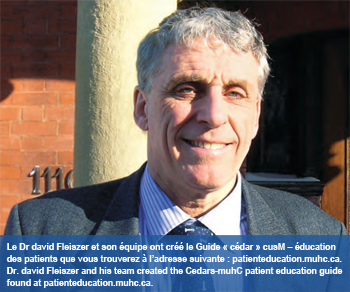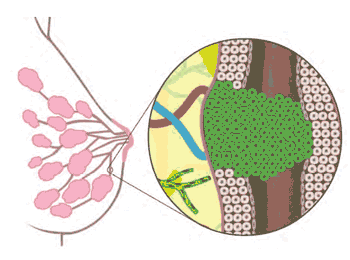From sketches to the Internet
 Prior to performing surgery, Dr. David Fleiszer likes to find some quiet time to discuss options with his patients. This McGill University Health Centre (MUHC) surgeon used to do this by drawing diagrams on slips of paper, but now he has gone high tech. Thanks to his efforts, patients can access clinical information on the newly launched Cedars-MUHC Patient Education Guide website (patienteducation.muhc.ca).
Prior to performing surgery, Dr. David Fleiszer likes to find some quiet time to discuss options with his patients. This McGill University Health Centre (MUHC) surgeon used to do this by drawing diagrams on slips of paper, but now he has gone high tech. Thanks to his efforts, patients can access clinical information on the newly launched Cedars-MUHC Patient Education Guide website (patienteducation.muhc.ca).
“I’m not an artist,” says Dr. Fleiszer. “But I found explaining medical options with pictures brought the message home to patients. In essence, I was holding a teaching session that ended with patients making a decision.”
FIRST MODULE IS ON BREAST CANCER
Making this picture-based information session available to all patients became the goal of Dr. Fleiszer and his team of health care professionals. They chose to work initially on a module about breast cancer. The result is a highly visual, multimedia-based teaching tool that incorporates easy-to-understand information on diagnosis, treatments, surgical procedures, and self-care.
“My first reaction was ‘Oh my God, I wish I had this when I was going through my chemo and radiation therapy’,” says former patient Marlene Lallo. “I was really impressed with the program. It is comprehensive, user friendly, and most importantly the information is reliable and accurate.”
With funding from groups led by the Cedars Cancer Institute, and supported by the Montreal General Hospital Foundation and the Molson Foundation, the patient education team has identifi ed sixteen other cancer information modules they will create. Among these are: prostate, colon, brain, thyroid, and lung cancers and a soon-to-be-completed guide on ovarian cancer.
AIMING FOR THE RIGHT AUDIENCE

The first step in creating these modules was to see what information was already available and to determine the demographics of potential users.
“There are a lot of really good medical websites with excellent, well-supported information. However, there is a huge gap in the literacy levels between the readers and the writers,” says Dr. Fleiszer. He explains that typically, medical information websites are written at a literacy level of grade 11, while average North American users have a reading level of grade five or six.
The MUHC’s approach was to develop a patient resource that has minimal writing. “We try to tell the whole story with pictures,” adds Dr. Fleiszer. Lallo agrees that the limited language and jargon makes the Cedars Breast Patient Education Guide easy to understand. “Other programs have contradictory information and involve a lot of reading. The Education Guide is very clear.”
BRINGING PROFESSIONALS TOGETHER
A beneficial side effect of bringing together multidisciplinary health care professionals to create these web modules has been to increase their interactions.
“We are finding that the exercise of creating the modules is really enhancing the care that the MUHC delivers. Everyone is on the same page,” comments Dr. Fleiszer. “What we are doing is capturing the expertise at the MUHC and distributing it to the people who need it.”
